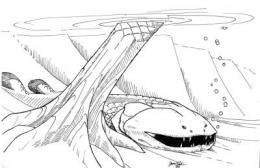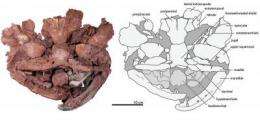New species of ancient predatory fish discovered

The Academy of Natural Sciences today announced the discovery of a new species of large predatory fish that prowled ancient North American waterways during the Devonian Period, before backboned animals existed on land.
Drs. Edward "Ted" Daeschler and Jason Downs of the Academy and colleagues from the University of Chicago and Harvard University describe the new denizen of the Devonian they named Laccognathus embryi in the current issue of the Journal of Vertebrate Paleontology.
The 375-million-year-old beast was discovered by the same group of researchers who discovered Tiktaalik roseae, the important transitional animal considered "a missing link" between fish and the earliest limbed animals. The fossil remains of the new species were found at the same site as Tiktaalik, on Ellesmere Island in the remote Nunavut Territory of Arctic Canada.

The Devonian Period (415 to 360 million years ago) is often described as the Age of Fishes because of the rich variety of aquatic forms that populated the ancient seas, lagoons and streams. Laccognathus embryi is a lobe-finned fish whose closest living relative is the lungfish. The creature probably grew to about 5 or 6 feet long and had a wide head with small eyes and robust jaws lined with large piercing teeth. "I wouldn't want to be wading or swimming in waters where this animal lurked," said Daeschler, co-author of the paper and the Academy's curator of vertebrate zoology. "Clearly these Late Devonian ecosystems were vicious places, and Laccognathus filled the niche of a large, bottom-dwelling, sit-and-wait predator with a powerful bite."
The researchers named the new species in honor of Dr. Ashton Embry, a Canadian geologist whose work in the Arctic islands paved the way for the authors' paleontological explorations.

The kind of fish known as Laccognathus (translates as pitted jaw) was previously only known from Eastern Europe. The discovery of Laccognathus embryi, the new species, extends the geographic range of Laccognathus to North America and confirms direct connection of the North American and European landmasses during the Devonian Period.
"This study is the culmination of a lot of work in the field, in the fossil lab, and in the office," said Downs, lead author of the study. Downs, an Academy research associate and a visiting professor at Swarthmore College, started studying fossils in high school as an Academy volunteer. "Our team collected the first fossils of Laccognathus almost 10 years ago, and the collection has grown with each subsequent field season. The quality and quantity of this collection will continue to shed new light on these unusual animals."
Provided by Academy of Natural Sciences

















